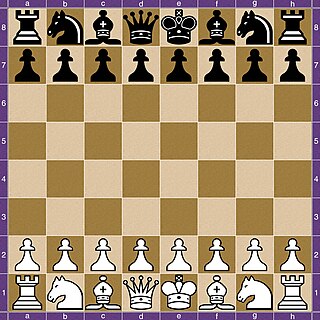In chess, irregular opening is a traditional term for any opening considered unusual or unorthodox. In the early 19th century it was used for any opening not beginning with 1.e4 e5 or 1.d4 d5. As opening theory has developed and openings formerly considered "irregular" have become standard, the term has been used less frequently.
The Sokolsky Opening is an uncommon chess opening that begins with the move:
This glossary of chess explains commonly used terms in chess, in alphabetical order. Some of these terms have their own pages, like fork and pin. For a list of unorthodox chess pieces, see Fairy chess piece; for a list of terms specific to chess problems, see Glossary of chess problems; for a list of named opening lines, see List of chess openings; for a list of chess-related games, see List of chess variants.
The Philidor Defence is a chess opening characterised by the moves:
The Réti Opening is a hypermodern chess opening whose "traditional" or "classic method" begins with the moves:
The Amar Opening is a chess opening defined by the move:
The Clemenz Opening is a chess opening beginning with the move:
The Mieses Opening is a chess opening that begins with the move:
The Saragossa Opening is a chess opening defined by the opening move:
Barnes Opening is a chess opening where White opens with:
The Ware Opening, also known as Meadow Hay Opening, is an uncommon chess opening for White beginning with the move:
The King's Pawn Game is any chess opening starting with the move:
The Inverted Hungarian Opening or Tayler Opening is an uncommon chess opening that starts with the moves:
The Durkin Opening is a rarely played chess opening.
The Keres Defence is a chess opening characterised by the moves:
The Colle System, also known as the Colle-Koltanowski System, is a chess opening system for White, popularized in the 1920s by the Belgian master Edgard Colle and further developed by George Koltanowski.
The Queen's Knight Defense is a chess opening defined by the moves:

Louis Paulsen was a German chess player. In the 1860s and 1870s, he was among the top players in the world. He was a younger brother of Wilfried Paulsen.

The game of chess is commonly divided into three phases: the opening, middlegame, and endgame. There is a large body of theory regarding how the game should be played in each of these phases, especially the opening and endgame. Those who write about chess theory, who are often also eminent players, are referred to as "theorists" or "theoreticians".
The Van 't Kruijs Opening is a chess opening defined by the move:


